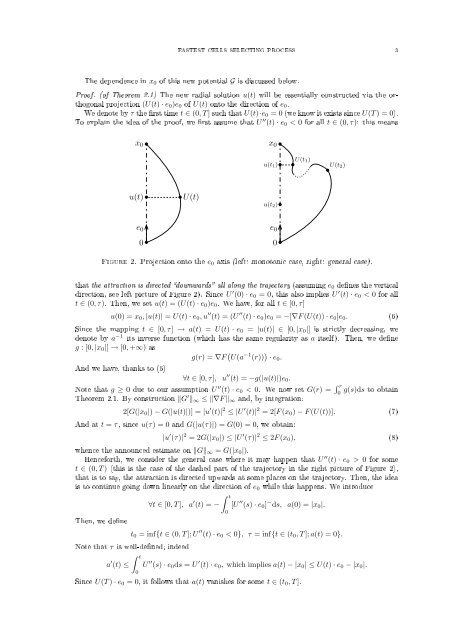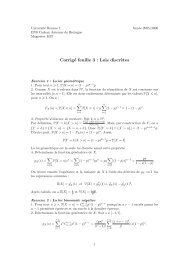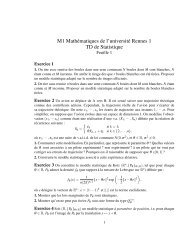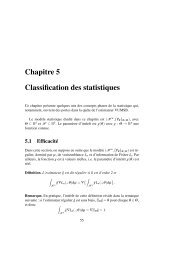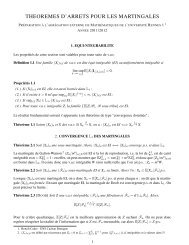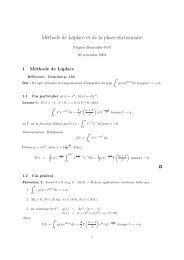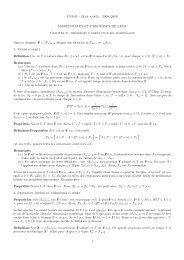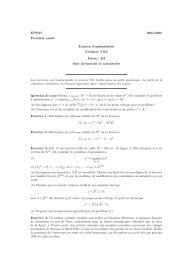2 MICHEL PIERRE AND GRÉGORY VIALwhere k is a strictly positive constant in the case of negative dielectrophoresis, and Θ = Θ(U ′ ) takesinto account the friction <strong>for</strong>ces (which are always present in the experiments un<strong>de</strong>r consi<strong>de</strong>ration).We want to control the shape of the electro<strong>de</strong>s so that the <strong>cells</strong> arrive as fast as possibleto the point where E 2 reaches its minimum. The network of electro<strong>de</strong>s is assumed to be periodic.Our strategy is as follows: we rst <strong>de</strong>termine what should be the <strong>best</strong> attracting eld Ein<strong>de</strong>pen<strong>de</strong>ntly of any constraint: this is essentially a control problem <strong>for</strong> a family of evolutionsystems which is mathematically interesting <strong>for</strong> itself. Then, we try to optimize the shape of theelectro<strong>de</strong>s in or<strong>de</strong>r to be as close as possible to this <strong>best</strong> eld. According to the law (1), the rststep consists in nding the <strong>best</strong> scalar function E 2 so that the solutions U(t) of (1), starting withzero velocity, reach the point where E 2 is minimum (say the origin) as fast as possible.A rst helpful reduction is the following (see Section 2.1 <strong>for</strong> a proof): let x 0 be a startingposition <strong>for</strong> a single particle with initial velocity zero. Given an attracting potential F = E 2 , onecan always replace it by a radial attracting eld of at most the same size, which will make theparticle reach the origin in a shorter time. It is well known that the shortest path to reach a pointin R 3 is a straight line; however, it is not always the <strong>fastest</strong> as it is well known in many situations.We prove in Section 2.1 that it is actually the case here. This is why we will mainly consi<strong>de</strong>r radialpotentials later on in this paper.A next question is the following: what is the <strong>best</strong> radial attracting potential to bring a particlethe <strong>fastest</strong> possible from its initial position x 0 to the origin? Actually, it is easy to see (cf.Section 2.1) that the answer will strongly <strong>de</strong>pend on the starting point x 0 . Since we are moreinterested in accelerating a group of particles with a same electric eld, we will rather minimizethe average time necessary <strong>for</strong> a distributed group of particles to reach the origin. This question isanalyzed in Section 3. We prove existence and uniqueness of a <strong>best</strong> scalar eld E 2 . Surprisingly,the question leads to integral equations, one of them being well-known in the literature as the Abelintegral equation see (24).Next, we will try to <strong><strong>de</strong>sign</strong> the <strong>fastest</strong> shapes of the electro<strong>de</strong>s by being as close as possibleto the previously obtained <strong>best</strong> radial attracting eld. We use a least square method and theobjective function to be minimized is an euclidian distance between the expected eld and the<strong>best</strong> eld found be<strong>for</strong>e. This is analyzed numerically in Section 4.2. Towards the optimization problem.2.1. Reduction to radial elds. As stated in the introduction, we prove here that one canalways do better (= faster) with radial elds. We will essentially discuss the case when Θ ≡ 0 (nofriction). As explained in Ÿ 2 and Theorem 2.2, it is not dicult to modify the analysis so as toinclu<strong>de</strong> this term. But the analysis is less technical without it and easier to read while nothing ofthe essential part is lost.We <strong>de</strong>note by | · | the euclidian norm in R N . Let F : R N \ {0} → [0, +∞) be a C 2 -function with∇F boun<strong>de</strong>d in a neighborhood of the origin 0 and F (0) := lim |r|→0 F (r) = 0. Let us consi<strong>de</strong>r thesolution ofU ′′ (t) = −∇F (U(t)), U(0) = x 0 , U ′ (0) = 0. (2)This solution exists globally in time since: |U ′ | 2 = 2[F (x 0 ) − F (U)] ≤ 2F (x 0 ). We assume thatU(T ) = 0 <strong>for</strong> some T > 0 and we set e 0 := x 0 /|x 0 |.Theorem 2.1. There exists t 0 ∈ [0, T ), τ ∈ (t 0 , T ], G ∈ C 1 [0, |x 0 |] andu ∈ C 2 ([t 0 , τ]; R N ) such that,∀t ∈ (t 0 , τ), u ′′ (t) = −G ′ (|u(t)|)e 0 , u(t 0 ) = x 0 , u ′ (t 0 ) = 0, (3)G(0) = 0, ‖G‖ ∞ = G(|x 0 |) ≤ F (x 0 ), ‖G ′ ‖ ∞ ≤ ‖∇F ‖ ∞ . (4)u(τ) = 0, and ∀ t ∈ [t 0 , τ], |u(t)| ≤ |U(t)|. (5)Remark 1. Let us set: ∀x ∈ R N , G(x) = G(|x|). Then, <strong>for</strong> x ∈ [0, x 0 ], one has ∇G(x) = G ′ (|x|)e 0 .This theorem shows that, given x 0 , we may replace the initial potential F by a radial potential Gin such a way that the accelerated particle u(t) reaches the origin at least as fast as (and most ofthe time, faster than) the previous one U(t) and this, with a potential G boun<strong>de</strong>d above by F aswell as ∇G boun<strong>de</strong>d above by ∇F see (4).
FASTEST CELLS SELECTING PROCESS 3The <strong>de</strong>pen<strong>de</strong>nce in x 0 of this new potential G is discussed below.Proof. (of Theorem 2.1) The new radial solution u(t) will be essentially constructed via the orthogonalprojection (U(t) · e 0 )e 0 of U(t) onto the direction of e 0 .We <strong>de</strong>note by τ the rst time t ∈ (0, T ] such that U(t)·e 0 = 0 (we know it exists since U(T ) = 0).To explain the i<strong>de</strong>a of the proof, we rst assume that U ′′ (t) · e 0 < 0 <strong>for</strong> all t ∈ (0, τ): this meansx 0 •x 0 •u(t)•e 0•U(t)u(t 1 )•u(t 2 )•e 0• U(t 1)• U(t 2)0•0•Figure 2. Projection onto the e 0 axis (left: monotonic case, right: general case).that the attraction is directed downwards all along the trajectory (assuming e 0 <strong>de</strong>nes the verticaldirection, see left picture of Figure 2). Since U ′ (0) · e 0 = 0, this also implies U ′ (t) · e 0 < 0 <strong>for</strong> allt ∈ (0, τ). Then, we set u(t) = (U(t) · e 0 )e 0 . We have, <strong>for</strong> all t ∈ [0, τ]u(0) = x 0 , |u(t)| = U(t) · e 0 , u ′′ (t) = (U ′′ (t) · e 0 )e 0 = −[∇F (U(t)) · e 0 ]e 0 . (6)Since the mapping t ∈ [0, τ] → a(t) = U(t) · e 0 = |u(t)| ∈ [0, |x 0 |] is strictly <strong>de</strong>creasing, we<strong>de</strong>note by a −1 its inverse function (which has the same regularity as a itself). Then, we <strong>de</strong>neg : [0, |x 0 |] → [0, +∞) asg(r) = ∇F ( U(a −1 (r)) ) · e 0 .And we have, thanks to (6)∀t ∈ [0, τ], u ′′ (t) = −g(|u(t)|)e 0 .Note that g ≥ 0 due to our assumption U ′′ (t) · e 0 < 0. We now set G(r) = ∫ rg(s)ds to obtain0Theorem 2.1. By construction ‖G ′ ‖ ∞ ≤ ‖∇F ‖ ∞ and, by integration:2[G(|x 0 |) − G(|u(t)|)] = |u ′ (t)| 2 ≤ |U ′ (t)| 2 = 2[F (x 0 ) − F (U(t))]. (7)And at t = τ, since u(τ) = 0 and G(|u(τ)|) = G(0) = 0, we obtain:|u ′ (τ)| 2 = 2G(|x 0 |) ≤ |U ′ (τ)| 2 ≤ 2F (x 0 ), (8)whence the announced estimate on ‖G‖ ∞ = G(|x 0 |).Hence<strong>for</strong>th, we consi<strong>de</strong>r the general case where it may happen that U ′′ (t) · e 0 > 0 <strong>for</strong> somet ∈ (0, T ) (this is the case of the dashed part of the trajectory in the right picture of Figure 2),that is to say, the attraction is directed upwards at some places on the trajectory. Then, the i<strong>de</strong>ais to continue going down linearly on the direction of e 0 while this happens. We introduceThen, we <strong>de</strong>ne∀t ∈ [0, T ], a ′ (t) = −∫ t0[U ′′ (s) · e 0 ] − ds, a(0) = |x 0 |.t 0 = inf{t ∈ (0, T ]; U ′′ (t) · e 0 < 0}, τ = inf{t ∈ (t 0 , T ]; a(t) = 0}.Note that τ is well-<strong>de</strong>ned; in<strong>de</strong>eda ′ (t) ≤∫ t0U ′′ (s) · e 0 ds = U ′ (t) · e 0 , which implies a(t) − |x 0 | ≤ U(t) · e 0 − |x 0 |.Since U(T ) · e 0 = 0, it follows that a(t) vanishes <strong>for</strong> some t ∈ (t 0 , T ].


